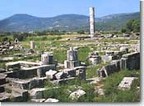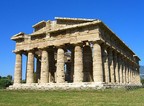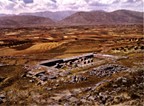Greece is a country of high mountains, dense forests and the sea. It is located by the Mediterranean Sea and boasts of innumerable beaches and ports that are worth visiting. However, Greece also boasts of many man-made marvels. These are the ancient architectural buildings and art objects that one can find in selected spots across Greece. These archaeological sites are always objects for photographing. Such Photographing archaeological sites in Greece is resorted to by tourists, students, scholars of art, archaeology, photography or history, business travelers and even the Greeks themselves. In fact, the travelers to Greece almost never visit the different tourist spots in Greece without also visiting the architectural sites, which are actually a few of the oldest such sites seen anywhere in the world. Thus, one can find innumerable tourists visiting such ancient architectural marvels like the Acropolis that also houses the Parthenon, Delphi, Olympia and Knossos, armed with various types of photographic cameras.
- Regulation of Photographing archaeological sites in Greece
The Greek government regulates the entry and photography of all archaeological sites very strictly. However, in recent times, it has tried to introduce certain relaxations in the rules. Thus, the government now allows all visitors to the archaeological sites to photograph or film the features of the site for fees that are not as prohibitive as before. Photographing archaeological sites in Greece is already quite popular among both domestic and foreign tourists. Now, the government has also allowed many films to be shot at these historical and ancient sites that are actually held as national treasures.
Some of the top archaeological sites are a must see for serious students of archaeology and the arts. One such site is the Greek site in Olympia whose re-excavation led to the modern Olympic Games. Olympia is also the site where in ancient times the festival of Zeus used to be held. Another popular site where tourists visit and relive mythology is Delos. This is an island located in the Aegean Sea and is known as the birthplace of two mythological gods. Apollo and Artemis. Isthmia is another site where one can find Roman and Greek excavations which any serious student of archaeology should visit. Not only that, such students should also consider photographing archaeological sites in Greece to take home and study the photographs further. Knossos, another great archaeological site has a palace that is also worth seeing and photographing. Delphi is another great archaeological site and one which is actually a classical Pan-hellenic Greek sanctuary. No wonder that many tourists rarely forgo Photographing archaeological sites in Greece even for such high fees that the Greek government charges for visiting and photographing the sites.
- Kinds of archaeological sites in Greece
All types of archaeological structures can be found in Greece. Thus, one can find monasteries, temples, huge bronze statues, royal tombs, ancient and historical coves, ampi-theaters and so on. Monasteries are found in sites located on Mount Athos, Meteora, as also in Daphni, the Island of Chios and Hosios Lucas. The royal tomb of Philip II can be found at the archaeological site in Vergina which was once the capital city of Macedonia. Again, the archaeological cities of Mycenae and Tiryns are what well known as cities depicted in Iliad and Odyssey, two great Homeric epics that have significantly influenced European art and literature over several hundred years. Many of these archaeological sites are actually world heritage sites and are protected places. Yet, the government allows all types of Photographing archaeological sites in Greece and this is indeed heartening for all visitors to the country. No visitor to this great country should neglect visiting the marvelous archaeological and historical sites that are spread all across Greece and includes palaces, museums, open-air theatres, tombs, temples and monasteries that stand testimony to man’s abilities to create some of the finest architectural and art specimens of the ancient and medieval period in human civilization. Photographing archaeological sites in Greece is needed so that the younger generation can know about such fine archaeological structures in Greece. This will make the future generation remember history of human civilization in all its ancient and modern greatness. In this respect, the Greek government has already relaxed rules of photography and video shoots of the archaeological sites.
- Free admissions to archaeological sites in Greece
The authorities allow in visitors to many of the archaeological sites on Sundays and national holidays. The national holidays in each year include January 6, February 27, April 13, 14 and 16, June 3-4, August 15 and October 28. There are also several free admission days in each and every year. Additionally, the free days in year 2012 included April 18, May 18, May 19, June 5, September 27 and several Sundays. Again, all Sundays through November to March each year and the first Sunday each month excluding July, August and September are also days when visitors are allowed in free to visit the archaeological sites in Greece. The Greek Ministry of Culture and Tourism has the authority to regulate the entry and closure timings as well as the free entry to the sites. However, Photographing archaeological sites in Greece is still allowed for a fee, often considered hefty in relation to entry fees to archaeological sites in other parts of the world. Free admission is available to students or youngsters under age 18 years from the EU countries, children up-to five years from non-EU countries, archaeologists, archaeology students, journalists, Greek military personnel, Members of Greek Parliament, official guests, disabled persons and their assistants, teachers accompanying students studying in primary or secondary schools visiting such archaeological sites on school educational trips and also to licensed tour guides. Greeks and EU citizens who are 65 years or above are also allowed reduced entry throughout the year. However, there is no restriction on Photographing archaeological sites in Greece generally if appropriate fees are paid.


